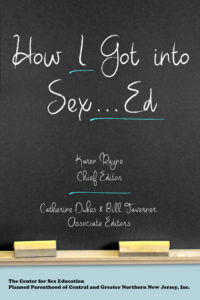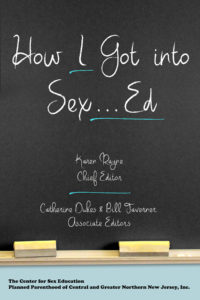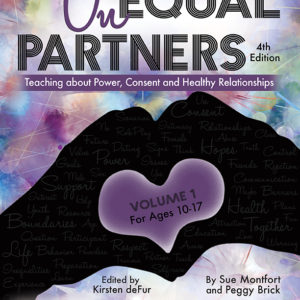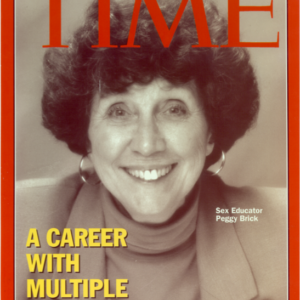We are running excerpts from How I Got Into Sex…Ed. Get a free copy of the ebook here. Order the print book here.
Peggy Brick, MEd
How I Got Into Sex…Ed
At 85 years of age, I’m challenged to tell “how I got into sex… education.” I wonder, did it begin at Camp TeAta where, for 13 summers, we girls tried to figure it all out, particularly the “old bags shack” where our favorite counselors lived and who (we whispered) were lesbians? Or was it at home where Mother frequently warned that her bridge club friends were talking about “those girls who necked in the back of the movie theater and had a bad reputation?” Or was it at college, where rumors about who was “doing it” were spread with awe and fascination? Possibly the most important reason for my becoming a sex educator was my foundation in sociology and psychology at Ohio Wesleyan University and as a graduate student at Columbia University, 1946–1951.
Of course, hundreds of experiences had prepared me for the fall of 1969 when peripatetic psychologist and sex educator Sol Gordon arrived at Dwight Morrow High School (DMHS) in Englewood, NJ. Sol was hired to help me develop full-year courses in psychology and sociology that would, Sol being Sol, include sexuality. Thus began my 40-year journey as a sex educator.
But first, I had to become a teacher. This began in 1964 when our three children were all in school and Allan, my unfailingly supportive husband, reported a radio announcement about a program called Project Mission, created by the Ford Foundation, which would prepare teachers for work in the inner city. What a great opportunity! A year later, I’d watched 12 “master teachers” demonstrate a variety of approaches to connecting successfully with 12- to 14-year-old children in an all-Black school in Baltimore, MD. For the next two years, encouraged to create and experiment, I developed my interactive approach to teaching that was enhanced by the theory of Paulo Friere’s Pedagogy of the Oppressed. Twenty years later, I gave a keynote, “Toward a Pedagogy of Sexuality: Education for Critical Consciousness” at the World Association of Sexuality in Hong Kong.
But back to DMHS, where I “got into” sex education. For the year, Sol Gordon and I taught seven classes, five sociology and two psychology, and — here’s the key to my future life — at the end of the year, we brought all those students to the auditorium for a “Sex Week.” We showed provocative sex ed films from Canada, and Sol waved his arms as he gave his inimitable responses to anonymous student questions. The dedication to Sol Gordon in Older, Wiser, Sexually Smarter: 30 Sex Ed Lessons for Adults Only includes one of his oft repeated aphorisms:
“Authorities say masturbation is ok…
[Then he’d pause and continue slowly.]
…if you don’t do it…
[Then he’d pause again.]
…too much!
[He’d give a little laugh.]
…but nobody knows…
[He’d pause again and say faster and louder,]
…how much is too much!
[And, after the laughter subsided, he would say,]
…and once is too much if you don’t like it.”
Sol was an inspiration; think of the wisdom in that silly “joke.”
Sol left, and during the next 15 years I created a 10-week unit, “Human Sexual Behavior,” a popular finale to the full-year, elective courses. Using a multidisciplinary approach, we examined, for example, the history of contraceptives and condoms, the differences between sexually repressive and sexually permissive societies, new research on adolescent sexual behavior in the United States, and contemporary theories on the role of parents in sex education. Most lessons began with a values clarification exercise designed to challenge students to think about each topic in terms of their personal beliefs. Frequently, students worked in small groups, discussing scenarios they had suggested anonymously. Roleplaying difficult situations was especially popular with students who were unsuccessful when doing traditional academic work, but highly successful when acting out their real-life problems. My only poor evaluation came from one supervisor who, while watching students acting and role-playing, complained that “I wasn’t teaching.” I requested a re-evaluation and gave a traditional stand-up lecture, which was graded “excellent.” When will they ever learn?
One of my favorite lessons was “Silent Day.” Students entered silently and for the full period read whatever they chose from Changing Bodies, Changing Lives. I remember one timid 15-year-old boy telling me as he left that he’d chosen to read about rape because an old woman in his apartment building had been raped that week. I learned, once again, how varied and how profound are people’s needs for sexuality education that is sensitive to their particular concerns. A “Sex Questions” box on my desk always invited anonymous questions, and every course I’ve taught since, including those on Sexuality and Aging, has begun with anonymous questions. Questions reveal the inadequacy of rigid curricula and help teachers understand the concerns that must be addressed if sex education is to have a significant impact on students’ lives.
But I was a very atypical sexuality educator. I was teaching in a liberal, supportive community where, when I described the sex unit on parents’ night, the common response was, “I wish I could take that course!” While other sex educators were attacked as the Far Right targeted sex education, the only question I ever had was from a board member who disapproved of a single question on a 70-item “Sex Knowledge Pre-Test” I had distributed in advance of the Sexual Behavior Unit. For a week students could search for answers from parents, teachers, or anyone they chose. The board member asked, “Why did students need to know that ‘25% of people over 75 years of age still had intercourse?’” I explained my belief that we are sexual from birth to death and that students needed to understand that older people were still sexual. We agreed to disagree. Ironically, I retired at age 70, and the topic of sexuality and aging has been my passion ever since.
I was atypical in other ways. The majority of sex education teachers were coaches or health educators. Their focus was pregnancy and STD prevention, which emphasized the dangers of sex. Most had no professional development in sex education, were ill-prepared to teach this sensitive subject, and surely didn’t think of themselves as “sexuality educators.” I did. I attended AASECT conferences, gave “State of Sexuality Education” presentations at Eastern Region SSSS meetings, and became devoted to SIECUS, writing for the SIECUS Report and eventually becoming chair of the board of directors.
Over the years, I continued to discover wondrous new ways to “get into sex ed.” In 1984, I left DMHS and soon became director of education at Planned Parenthood of Bergen County, NJ (now the amazing CFLE at Planned Parenthood of Central and Greater Northern New Jersey [PPCGNNJ]). There, an enthusiastic board and supportive CEOs understood the many benefits to the agency of a strong education department and encouraged our creative approach to providing sex education across the lifespan. Suddenly, being a sex educator meant developing grants, creating teaching manuals, providing graduate courses for teachers, facilitating professional development workshops across the nation, and writing articles that articulated my theory and practice of sexuality education. Now more than 30 years old, my first article, “Sex and Society: Teaching the Connection” in the Journal of School Health, expressed my conviction that meaningful sex education helps students examine the “mixed messages” they receive from a “sexually confused and confusing society.”
To really “get into sex ed,” I had to be a student of that society. Always, I was guided by books, including Sexual Conduct: The Social Sources of Human Sexuality by John Gagnon and William Simon; Intimate Matters: A History of Sexuality in America by John D’Emilio and Estelle B. Freedman; and Sex is Not a Natural Act by my provocative mentor, Leonore Tiefer. While many sex educators felt they were relegated to a low status among researchers and therapists, I was privileged to meet monthly in New York City with a group of feminist sexologists who respected me as an educator and challenged me to think and rethink my pedagogy. My feminist perspective was articulated in an article entitled “Sex Education is a Feminist Issue” in the groundbreaking journal, New Directions for Women, and for nine years, its editor, Phyllis Kriegal, and I provided professional development workshops through our agency, Affirmative Teaching Associates.
It was this stimulating background that enabled me to work with an enthusiastic staff at the CFLE to target deficits in current sex education curricula. Together we created exciting teaching manuals that featured interactive activities that examined feelings, attitudes, values, and beliefs and developed the skills needed for helping students to integrate information into their lives. Thus, Positive Images: A New Approach to Contraceptive Education replaced boring lectures on contraceptive devices; Teaching Safer Sex replaced HIV films focused on T-cells; and Unequal Partners challenged students to think about the quality of their relationships. Bodies, Birth, and Babies and Healthy Foundations taught early childhood teachers and parents about young children’s sexual behaviors.
In a rapidly changing society, getting into sex ed is a continuing adventure. Creative educators will always be seeking new ways to reach students with various needs at various stages of life. For example, right now there’s a profound need for resources to prepare staff to understand and respect the sexual rights of old people, especially residents in long-term care facilities, many with dementia. Oh! I do wish I were just “getting into sex…ed.”

Want to read other great stories? Get a free copy of the ebook here. Order the print book here.
“How I Got Into Sex…Ed is a treasure! If you’ve ever wondered if this path was right for you or what it feels like to be a sex educator or how to get the right kinds of education, training, or opportunities to work as a sexuality education professional, this book is for you!”
Debby Herbenick, PhD, MPH
Director, The Center for Sexual Health Promotion
Indiana University






